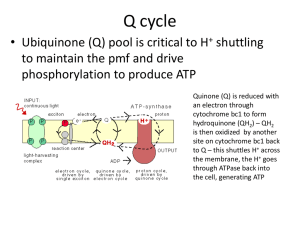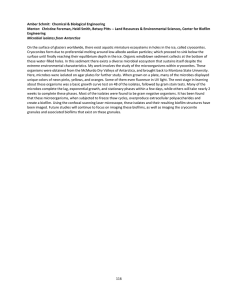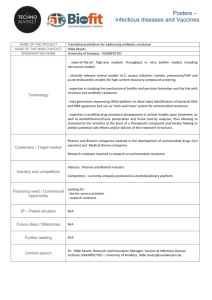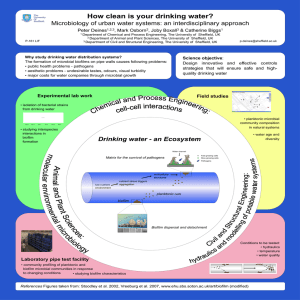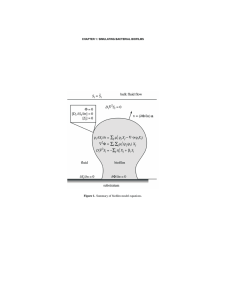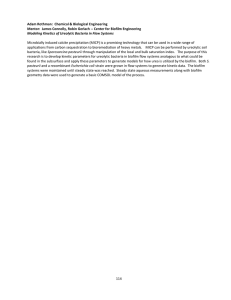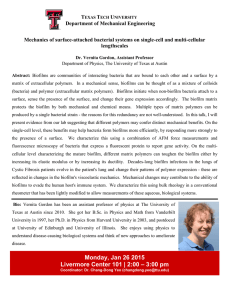Applications of Biotechnology in Development of Biomaterials
advertisement
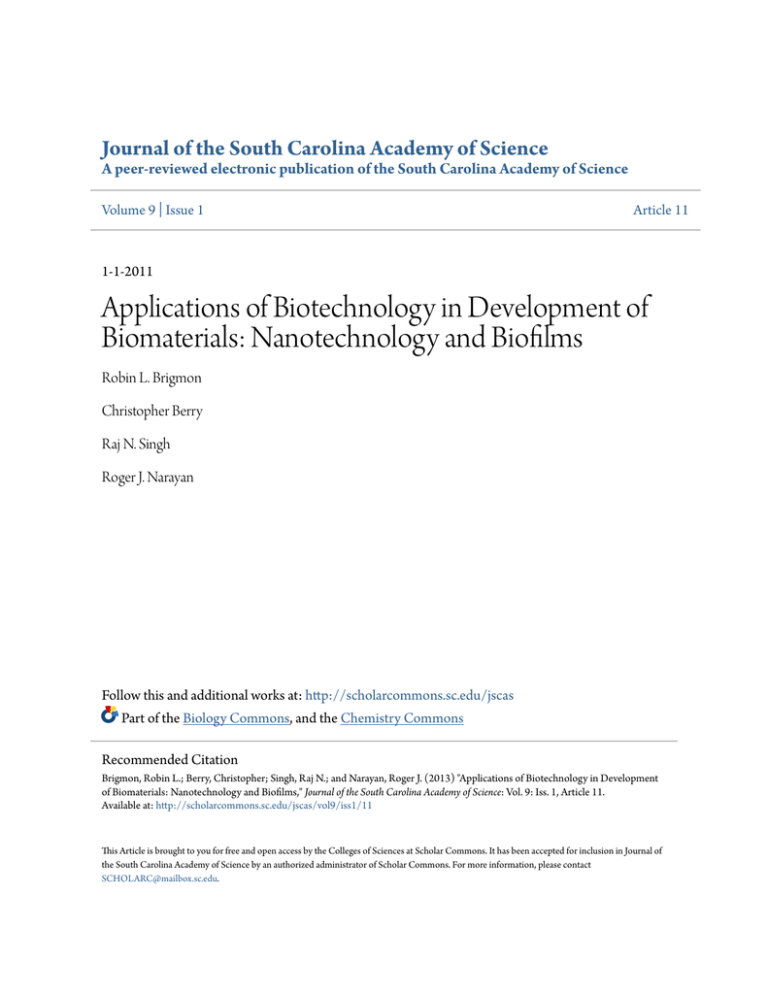
Journal of the South Carolina Academy of Science A peer-reviewed electronic publication of the South Carolina Academy of Science Volume 9 | Issue 1 Article 11 1-1-2011 Applications of Biotechnology in Development of Biomaterials: Nanotechnology and Biofilms Robin L. Brigmon Christopher Berry Raj N. Singh Roger J. Narayan Follow this and additional works at: http://scholarcommons.sc.edu/jscas Part of the Biology Commons, and the Chemistry Commons Recommended Citation Brigmon, Robin L.; Berry, Christopher; Singh, Raj N.; and Narayan, Roger J. (2013) "Applications of Biotechnology in Development of Biomaterials: Nanotechnology and Biofilms," Journal of the South Carolina Academy of Science: Vol. 9: Iss. 1, Article 11. Available at: http://scholarcommons.sc.edu/jscas/vol9/iss1/11 This Article is brought to you for free and open access by the Colleges of Sciences at Scholar Commons. It has been accepted for inclusion in Journal of the South Carolina Academy of Science by an authorized administrator of Scholar Commons. For more information, please contact SCHOLARC@mailbox.sc.edu. Applications of Biotechnology in Development of Biomaterials: Nanotechnology and Biofilms Keywords Biotechnology, Biomaterials, Nanotechnology, Biofilms This article is available in Journal of the South Carolina Academy of Science: http://scholarcommons.sc.edu/jscas/vol9/iss1/11 Applications of Biotechnology in Development of Biomaterials: Nanotechnology and Biofilms Robin L Brigmon1, Christopher Berry1, Raj N Singh2, and Roger J Narayan3 1 Savannah River National Laboratory, Aiken, SC, 29808 USA Department of Chemical and Materials Engineering, University of Cincinnati, Cincinnati, OH 45221-0012, USA 3 Joint Department of Biomedical Engineering, University of North Carolina and North Carolina State University, 2147 Burlington Engineering Labs, Raleigh NC 27695-7115 USA 2 Biotechnology is the application of biological techniques to develop new tools and products for medicine and industry. Due to various properties including chemical stability, biocompatibility, and specific activity, e.g. antimicrobial properties, many new and novel materials are being investigated for use in biosensing, drug delivery, hemodialysis, and other medical applications. Many of these materials are less than 100 nanometers in size. Nanotechnology is the engineering discipline encompassing designing, producing, testing, and using structures and devices less than 100 nanometers. One of the challenges associated with biomaterials is microbial contamination that can lead to infections. In recent work we have examined the functionalization of nanoporous biomaterials and antimicrobial activities of nanocrystalline diamond materials. In vitro testing has revealed little antimicrobial activity against Pseudomonas fluorescens bacteria and associated biofilm formation that enhances recalcitrance to antimicrobial agents including disinfectants and antibiotics. Laser scanning confocal microscopy studies further demonstrated properties and characteristics of the material with regard to biofilm formation. Introduction In recent years the development of nanotechnology has allowed the development of new materials to combat microbial biofilm formation on biomaterials. These advances in the use of nanostructured materials for medical applications have resulted from two primary considerations. First, there is a natural evolution to nanoscale materials as novel processing, characterization, modeling techniques, and technology for necessary manipulation and manufacturing becomes available. Second, specific interactions between biological structures (e.g., tissues and other cellular processes) and nanostructured materials may allow for devices with specific functionalities to be developed. Nanocrystalline diamond has recently been considered for use in preventing microbial growth (Leis et al., 2010). Diamondlike carbon-silver, diamondlike carbon-platinum, and diamondlike carbon-silver-platinum composite films have been prepared using a novel multicomponent target pulsed laser deposition process11. Silver and platinum form nanoparticle arrays within the diamondlike carbon matrix that can be attributed to the high surface energy of noble metals relative to carbon. Diamondlike carbon-silver-platinum composites exhibit significant antimicrobial efficacy against Staphylococcus bacteria11. Robust antimicrobial function has been observed in diamondlike carbon-silver-platinum composite films; this functionality is tentatively attributed to the formation of a galvanic couple between silver and platinum that enhances silver ion release12. Diamondlike carbon-metal composite films may provide higher hardness, corrosion resistance, and antimicrobial functionalities to next generation cardiovascular, orthopaedic, biosensor, and other biomedical devices. New applications of the antimicrobial properties of diamond-like carbon-silver-platinum nanocomposites may include catheters and other devices 14. Novel antimicrobial silver ion complex resinate compositions comprising a silver-thiosulfate ion complex loaded onto an organic anion exchange resin have been proven successful2. These silver thiosulfate ion complex resinate compositions are able to release stable antimicrobial silver ion complexes over time when placed in a saline environment. These antimicrobial silver-ion complex resinates can be useful in the treatment and prevention of infections and diseases. A stabilized composition having antibacterial, antiviral and/or antifungal activity utilizing a silver compound in the form of a complex with primary, secondary or tertiary amines has also proven effective for use in urine catheters (Pedersen; et al., 2002). The complex is associated to one or more hydrophilic polymers, remains stable during sterilization, and retains antimicrobial activity without giving rise to darkening or discoloration of the dressing during storage. An antimicrobial latex composition comprising a homogeneous blend of a natural/synthetic rubber latex and protein silver, and a second antimicrobial latex composition comprising a homogeneous blend of a cationic natural rubber latex or a cationic synthetic polymer latex and a water-soluble silver compound has also been developed16. Atomic layer deposition (also known as molecular layering or atomic layer epitaxy) is a thin film growth technique in which alternating controlled surface chemical reactions occur between gaseous precursor molecules14. The self-terminating gas-solid reactions allow for material to be applied in a layered methodology. Individual reactions are separated by purge steps that involve saturation with an inert gas. By saturating the substrate at each individual reaction, all surfaces of a given substrate can receive a uniform coating of thickness and composition. The atomic layer deposition cycles can be repeated to control precisely the coating thickness of any applied inorganic antimicrobial agent at the nano scale including TiO14. Atomic layer deposition has also been used to coat the surfaces of proposed biomaterials including nanoporous alumina membrane in order to reduce the pore size in a controlled manner4. Recent work on unmodified nanoporous alumina membranes has shown that release of biological Journal of the South Carolina Academy of Science, [2011], 9(1) 33 molecules in nanoporous alumina membranes is determined by the diameters of the pores9. Narayan et al., 2009, demonstrated that titanium oxide (TiO) coating can reduce the pore size in a controlled manner, maintain a narrow pore size distribution, prevent aluminum ions from leaching into the surrounding tissues, and create a biocompatible antimicrobial pore/tissue interface under the right conditions. In that work microbial results showed a significant decrease in the amount of microbial attachment to membranes treated with TiO with both Staphylococcus aureus and Escherichia coli. Biofilm are aggregates of microorganisms in which cells adhere to each other and/or to a surface. The associated cells are frequently embedded within a self-produced matrix of extracellular polymeric substance (EPS). Biofilm EPS is a polymeric conglomeration generally composed of extracellular DNA, proteins, and polysaccharides that can become highly organized, making it resistant to biocides. Biofilms may form on living or non-living surfaces, and represent a prevalent mode of microbial life in natural, industrial and hospital settings1. Biofilm formation in medical devices is inherently disruptive as it can lead to health concerns including infection 7. All novel biomaterial for use in medical devices must be tested to determine their resistance to biofilm development. In this study, the resistance of nanocrystalline diamond to growth of microbial biofilms in a continuous perfusion environment was examined. Materials and Methods CDC Bioreactors: A rotating disc reactor CDC biofilm reactor (Biosurface Technologies, Bozeman, MT, USA) containing silicon, silica glass, roughened silica glass, nanocomposite samples fixed to silica glass, and coated polycarbonate circular samples was used for microbial testing. The CDC biofilm bioreactor and all operating components were autoclaved prior to the testing. This CDC reactor consists of a 1-L vessel with an effluent spout at approximately 400 ml, which is connected to a waste bottle. Continuous mixing of the bulk fluid is ensured by a magnetically driven (RET digi-visc, IKA Labortechnik, Wilmington, MA, USA) baffled stir bar. A polyethylene lid supports eight independent rods, which each can house three removable circular disks. The lid also contains three stainless steel ports allowing the connection of two sterile (0.2 µm) vent filters (Millex®-FG, Millipore, Bedford, MA, USA) and an inlet for the diluted growth medium. All materials and growth medium were autoclaved prior to use. Low concentrations (1%) of Peptone-Trypticase-Yeast extract-Glucose (PTYG) medium was used3 as the growth medium. Initially, reactors were operated in batch mode for 24 h to establish the biofilms on the various substrata in 1% PTYG medium. Following the period of batch growth, the system was operated in chemostat mode by continuously pumping the 1% PTYG medium Pseudomonas fluorescens flow rate of 2 ml/min for 72 h. The nanocrystalline diamond material was described previously by Lewis et al10. Briefly, the nanocrystalline diamond samples were mounted on coupons on the rotating disc of the reactor. Bioreactor Sampling Coupon samples were removed at the three time points along with 4-1 ml aliquots of medium were aseptically removed at the following time points Time 0 – 1 ml Liquid Time 1-1h 25 min Liquid +coupons Time 2- 18h 10 min Liquid+coupons Time 3-24h 10 min Liquid+coupons All samples were immediately frozen @ -20ºC for later analysis. The bioreactor was maintained and mixed the entire test in a sterile lab hood @ 25°C. Microbial Analysis Bacteria densities were determined by Acridine Orange Direct Counts (AODC) as previously described 3. Digital mages of the stained cells on the coupons and materials were obtained using a laser confocal scanning microscope (Model LSM 510 Carl Zeiss Inc., Germany). Coupon samples were thawed, air dried in a sterile laminar flow hood, and then stained with 4, 6 diamidino-2-phenylindole (DAPI) to determine total microbial cells per microscopic field (Kastner et al., 2000). Images of the stained cells were obtained using a laser confocal scanning microscope (Model LSM 510 Zeiss, Germany). Results P. fluorescens densities in the Bioreactor medium ranged from 2.98 X 105 cells/ml at Time 0 to 1.56 X 105 cells/ml at Time 3. Flow though rate of medium was maintained at 2 ml/minute At sampling time 1 after one hour and twenty-five minutes there was little difference observed between the controls (frosted glass, clear glass, coupon, and half coupon only) and the diamond material so far as microbial attachment. All samples had some P. fluorescens cells attached as demonstrated by the LSCM image in Figure 1. The cells attach although the CDC bioreactor is constantly swirling the individual coupon holders. Some cells can be observed elongating and dividing indicating early biofilm formation. Note the orientation of the attached on the surface in Figure 1. Pseudomonas fluorescens (strain #B252) was the biofilm forming microorganism tested as previously described10. List of materials including controls placed in CDC biofilm bioreactor is as follows 1. Frosted glass 2. Clear Glass 3. Nanocrystalline diamond 4. Half nanocrystalline diamond, half smooth. 5. Control-coupon only-no material. Fig. 1 Attachment of Pseudomonas fluorescens cells mounted on coupon with transect showing scale after 1 hour 25 minutes. Journal of the South Carolina Academy of Science, [2011], 09(1) 34 At sampling time two, 18 hours and ten minutes after continuous exposure, biofilm was covering most of the control surfaces. Growth of P. fluorescens demonstrated partial coverage of the nanocrystalline diamond as shown in the LSCM image in Figure 2. The biofilm was up to 8 µm thick in some areas while others sections there was little growth. Note the cross-bridging occurring in Figure 2 (arrow). Once the two larger clumps of cells shown here are ‘tethered’ in this manner they will form larger biofilms. This demonstrates the biofilm as it grows in organization and structure. As the density of the biofilm increases so does the recalcitrance of the microbial cells on the inner layers to drug and/or biocide treatment such as antibiotics. Biofilm formation is also resistance to the body’s natural immunological defenses such as antibody production and or macrophage activity. P. fluorescens colonization on nanocrystalline diamond coating after 24 hr incubation was examined using a laser scanning confocal microscope (Figure 3A). This image shows a much larger more organized biofilm and smaller cell colonies. This particular larger biofilm formation on the slide center is roughly 40 µm by 60 µm size. The longer side is oriented with the flow of the CDC Bioreactor. Biofilms form with an initial attachment of cells that then begin dividing and forming a colony. Colonization allows more cells from the circulating medium to attach and grow. Figure 2 shows apparent attachment between P. fluorescens colonies that over time form larger units. Figure 3B is a side three dimensional view of P. fluorescens colony and biofilm formation on the nanocrystalline diamond surface observed in Figure 3A. Note the depth of the biofilm is up to 10 µm indicating robust growth. Growth of P. fluorescens was similar on the nanocrystalline diamond as compared to glass controls at all sampling times. On closer observation at 1300X with LSCM the surface of the mounted nanocrystalline diamond material appeared rough and angular, allowing microbial attachment and/or entrapment and subsequent colonization on the glass surface. Discussion Lewis et al. recently compared microbial growth on nanocrystalline diamond coated silicon wafers that were immersed in growth medium containing Pseudomonas fluorescens10. The results of that work demonstrated that nanocrystalline diamond coatings of surfaces did not prevent P. fluorescens growth under operant conditions . Another study demonstrated that Streptococcus mutans, a microorganism of concern in dental-related biofilms, uses a peptide pheromone quorum-sensing signal transduction system to stimulate the uptake and incorporation of foreign DNA. Experimentally the signal peptide can be chemically synthesized and added to cultures to stimulate transformation indicating microbial adaptation to changing environments in biofilms (Li et al., 2001). Fig. 3A Laser scanning confocal microscope three-dimensional image of P. fluorescens on nanocrystalline diamond. The image was taken after 24 hr in the reactor. Fig.2 Pseudomonas fluorescens cells forming a biofilm on the nanocrystalline diamond material after 18 hour 10 minutes. When there are mixed culture biofilms it may be possible for transfer of genetic information including antimicrobial resistance. Thus there is the possibility of microbial resistance to new surface treatment stategies. The pathogenesis of many orthopaedic infections has been related to the presence of microorganisms in biofilms (Patel, 2005). If the nanocrystalline diamond material had been milled or made smoother it may have changed the results found here. As described in the results the roughed surface of the nanocrystalline diamond appeared to aid microbial attachment. Quorum sensing is a biochemical signalling process many microbial species use to control their metabolism according to environmental conditions. The colony to colony connections Journal of the South Carolina Academy of Science, [2011], 9(1) 35 obeserved by P. aeruginosa cells in Figure 2 could be due to quorum sensing. Many bacteria use quorum-sensing systems in microbial colonies to regulate several physiological properties, including the ability to incorporate foreign DNA, tolerate acid, biofilm formation, and virulence5. Successful inhibition of quorum sensing in a P. aeruginosa biofilm by a halogenated furanone compound could lead to novel antimicrobial agents8. Either organic compounds such as furanone or inorganic nanomaterials like TiO that affect biofilm architecture and enhance microbial detachment that lead to a loss of bacterial biomass from surfaces would be useful for biomedical applications. useful for delivering a pharmacologic agent at a precise rate to a specific location in the body. Delivery could be based on the pharmacokinetics of the specific agent. These materials may serve as the basis for “intelligent” drug delivery systems, orthopaedic implants, or self-sterilizing medical and veterinary devices. Acknowledgements This document was prepared in conjunction with work accomplished under Contract No. DE-AC09-08SR22470 with the U.S. Department of Energy. References 1. Atlas, R.M., J. F. Williams, and M. K. Huntington.. Appl. Environ. Microbiol.. 1995, 61, 1208–1213. 2. Capelli. C. C. Antimicrobial silver ion complex resonates. United States Patent 7147845, 2006. 3. Brigmon, R.L., Franck, M.M., Bray, J.S., S. Lanclos, K., Scott, D., and Fliermans, C. B. J. Microbiol. Methods, 1998, 32, 1-10. Fig. 3B. Three dimensional side image of the same field as Fig. 3A of P. fluorescens growth on a nanocrystalline diamond coating taken after 24 hr. This image shows a biofilm attached to the nanocrystalline diamond coating as well as smaller clumps of cells. Conclusions Under these conditions nanocrystalline diamond coatings did not inhibit P. fluorescens attachment and biofilm formation in the CDC Biofilm Reactor10. It is evident that once initial microbial attachment and colonization occurs, subsequent biofilm formation is hard to control (Figure 3A & B). Combining potential antimicrobial materials may be necessary for optimal biomedical applications. Additional nanostructured materials with titanium and zinc coatings may be useful for inhibiting microbial attachment/colonization for certain biomedical applications including catheters. Silicon materials are associated with less inflammation than polymeric materials that are currently used for local drug delivery. In addition, these materials may provide greater flexibility in their applications, since there are often difficulties when pharmacologic agents and polymers are dissolved in a given solvent. Nanostructured materials prepared using atomic layer deposition may also be 4. Cameron, M. A, Gartland, I.P., Smith, J.A., S. F. Diaz, S.F., and George, S.M. Langmuir, 2000, 16, 7435–7444. 5. Cvitkovitch, D.G., Li, Y-H. and Ellen, R.P. J Clin Invest, 2003, 112, 1626–1632. 6. Donlan, R.M., and Costerton, J.W. Clin. Microbiol. Rev. 2002, 15, 167-93. 7. Hall-Stoodley, L., Costerton J.W. and Stoodley, P. Nature Rev. Microbiol. 2004, 2, 95-108 8. Hentzer, H., Riedel, K., Rasmussen, T. B., Heydorn, A., Andersen, J. B., Parsek, M. R., Rice, S. A., Eberl, L., Molin, S., Høiby, N., Kjelleberg, S., and Givskov, M. Microbiology, 2002, 148, 87-10. 9. Kipke, S. and Schmid, G. Advanced Functional Materials, 2004, 14, 1184-1188. 10. Lewis, J.S. S. D. Gittard, R. J. Narayan, C. Berry, R. L. Brigmon, R. Ramamurti, R. N. Singh. Journal of Manufacturing Science and Engineering, 2010, 132, 1-7. 11. Morrison, M.L., Buchanan, R.A., Liaw, P.K., Berry, C.J., Brigmon, R.L., Riester, L., Abernathy, H.; Jin, C. and Narayan, R. Diamond and Related Materials, 2006, 15, 138-146. 12. Narayan, R., C.B. Berry and R. L. Brigmon. Materials Science & Engineering B. 2005, 123, 123-129. 13. Narayan, R.J., H. Abernathy, L. Riester, C. J. Berry, and R. L. Brigmon. Journal of Materials Engineering and Performance, 2005, 6, 435-440. 14. Narayan R.J., N. A. Monteiro-Riviere, R. L. Brigmon, M.J. Pellin, J.W. Elam. JOM: the Journal of the Minerals, Metals & Materials Society, 2009, 61,12-16. 15. Puurunen, R. L. and Vandervorst, W. Journal of Applied Physics, 2004, 96, 7686-7695. 16. Umemura, Y., Ozaki, Y., Kawaide, A. Antimicrobial latex composition. US Patent 4902503, 1990. Journal of the South Carolina Academy of Science, [2011], 09(1) 36
